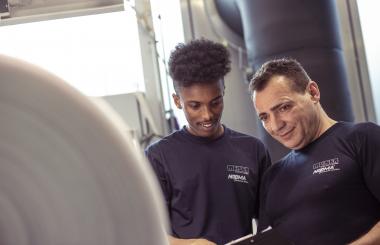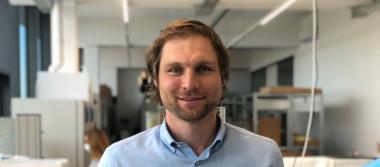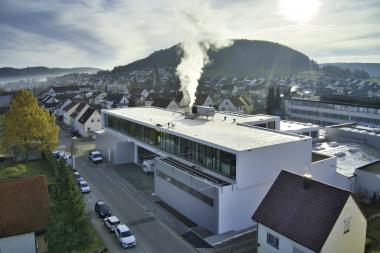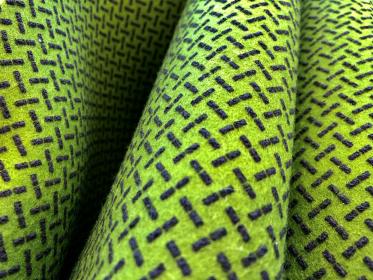Crops to tackle environmental harm of synthetics
From risottos to sauces, mushrooms have long been a staple in the kitchen. Now fungi are showing the potential to serve up more than just flavor—as a sustainable, bendy material for the fashion industry.
Researchers are using the web-like structure of the mushroom's root system—the mycelium—as an alternative to synthetic fibers for clothing and other products such as car seats.
"It's definitely a change of mindset in the manufacturing process," said Annalisa Moro, EU project leader at Italy-based Mogu, which makes interior-design products from the mycelium. "You're really collaborating with nature to grow something rather than create it, so it's kind of futuristic."
Mogu, located 50 kilometers northwest of Milan, is managing a research initiative to develop nonwoven fabrics made of mycelium fibers for the textile industry.
Called MY-FI, the project runs for four years through October 2024 and brings together companies, research institutes, industry organizations and academic institutions from across Europe.
MY-FI highlights how the EU is pushing for more sustainable production and consumption in the textile and apparel industry, which employs around 1.3 million people in Europe and has annual turnover of €167 billion.
While getting most of its textiles from abroad, the EU produces them in countries including France, Germany, Italy and Spain. Italy accounts for more than 40% of EU apparel production.
Delicate and durable
The mycelium grows from starter spawn added to crops such as cereals. The threadlike filaments of the hyphae, the vegetative part of the fungus, create a material that grows on top. It is harvested and dried, resulting in soft, silky white sheets of nonwoven fabric that are 50 to 60 square centimeters.
The delicate material is made stronger and more durable through the addition of bio-based chemicals that bind the fibers together.
Its ecological origins contrast with those of most synthetic fibers such as nylon and polyester, which derive from fossil fuels such as coal and oil.
That means production of synthetic fibers adds to greenhouse-gas emissions that are accelerating climate change. In addition, when washed, these materials shed microplastics that often end up polluting the environment including rivers, seas and oceans.
The MY-FI mycelium needs very little soil, water or chemicals, giving it greener credentials than even natural fibers such as cotton.
Dress rehearsal
For the fashion industry, the soft, water-resistant properties of the mycelium are as appealing as its environmental credentials.
Just ask Mariagrazia Sanua, sustainability and certification manager at Dyloan Bond Factory, an Italian fashion designer and manufacturer that is part of MY-FI.
The company has used the mycelium-based material—in black and brown and with a waxed finish—to produce a prototype dress, a top-and-midi-skirt combination, bags and small leather accessories.
Laser cutting and screen printing were used to evaluate the material's behavior. The challenge was to adapt to the sheets of fabric—squares of the mycelium material rather than traditional rolls of textiles like cotton, linen and polyester—as well as properties such as tensile strength and seam tightness.
"We have had to completely change the paradigm and design processes and garments based on the material," said Sanua.
The company hopes the mycelium material will be a way of offering consumers a range of products that can be alternatives to animal leather.
Leather-unbound
Meanwhile, Germany-based Volks¬wagen, the world's No. 2 car manufacturer, is looking to mycelium technologies to reduce its environmental footprint and move away from leather for vehicle interiors.
Customers increasingly want animal-free materials for interiors from seat covers and door panels to dashboards and steering wheels, so adding a sustainable substitute for leather is an exciting prospect, according to Dr. Martina Gottschling, a researcher at Volkswagen Group Innovation.
"A fast-growing biological material that can be produced animal-free and with little effort, which also does not require petroleum-based resources, is a game-changer in interior materials," she said.
The mycelium material is also lighter than leather, another positive for reducing VW's carbon footprint.
The company's involvement in MY-FI is driving project researchers at Utrecht University in the Netherlands and I-TECH Lyon in France to enhance the durability of the mycelium fabric. To move from prototype to production line, the fabric must meet quality requirements set by VW to ensure the material lasts for the life of the vehicle.
It's a challenge that Gottschling believes will be met in the coming decade.
"We already see the material as one of the high-quality materials for interior applications that will be possible in the future," she said.
When life gives you tomatoes
Mushrooms aren't the only food with the potential to spin a sustainable-yarn revolution. Tomato stems have a hidden talent too, according to Dr. Ozgur Atalay and Dr. Alper Gurarslan of Istanbul Technical University in Turkey.
Seeing tomato vines left to wither in the fields after the crop was harvested, Atalay and Gurarslan began to investigate whether the stems could be transformed into sustainable fibers.
Tests proved that the agricultural waste could indeed be turned into yarn. But Atalay and Gurarslan were determined to go a step further. They wanted to use tomato stems to create a type of yarn for garments that monitor heart beats, respiratory rates and joint movements.
The two researchers lead a project to create this kind of electrically conductive apparel using—for the first time—sustainable materials.
Called SMARTWASTE, the project runs for four years until the end of 2026 and also involves academic and research organizations from Germany, Italy, the Netherlands and Poland.
"The beauty of the project is that we are starting from waste," said Atalay. "We are taking agricultural waste and not just creating regular textiles but something much more valuable."
While cost estimates will follow later in the project when design partners work on creating actual products, he signaled that smart clothing will be a good deal more expensive than the ordinary kind.
A smart textile shirt could cost as much as €1,000, according to Atalay.
The specialized material, limited production runs and research and development needed to create wearable technologies that are durable, washable and comfortable all contribute to the price tag.
Advancements in technology should eventually lead to lower production costs and consumer prices.
Seeds of poplar success
The Turkish countryside has also inspired a second strand to the project. Turkey's abundant poplar trees and—more specifically—their white, fluffy cotton-like seeds prompted Gurarslan to investigate whether they could be a sustainable textile source.
While their fibers have been dismissed as too short to make a yarn, the seeds have three particular properties that appeal to the textile industry: a hollow, pipe-like structure that can trap heat to provide thermal qualities, an antibacterial nature and water resistance.
The network of SMARTWASTE experts has blended the seeds with recycled polyester to make a nonwoven fabric that the team intends to turn into textile products with enhanced thermal properties.
The researchers hope this is just the start of a far-reaching transformation of textiles.
"Our goal is to train the next generation of researchers and innovators in sustainable textiles," said Atalay.
MY-FI mycelium leather alternative automotive interiors Sustainability sustainable textile production







